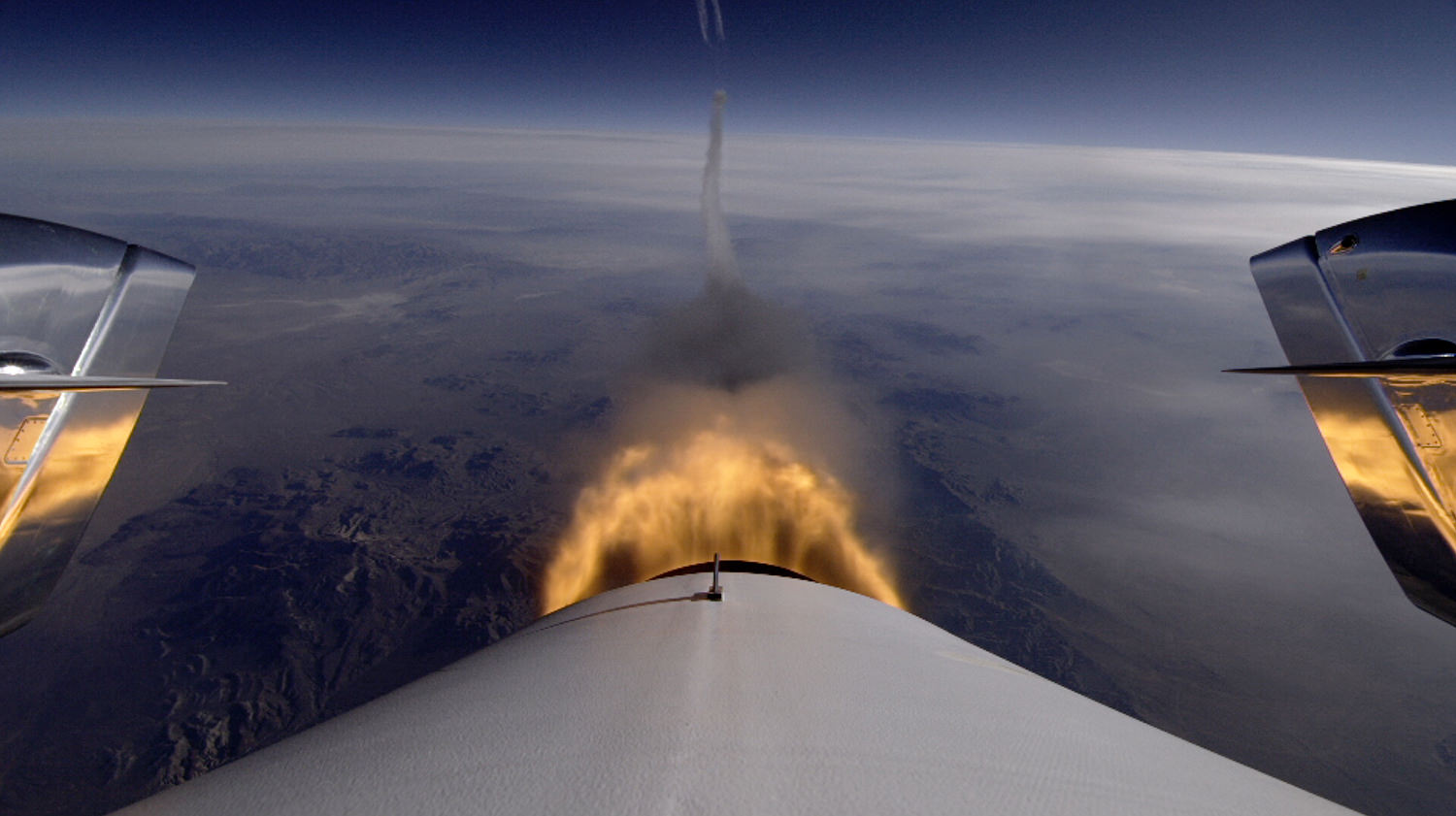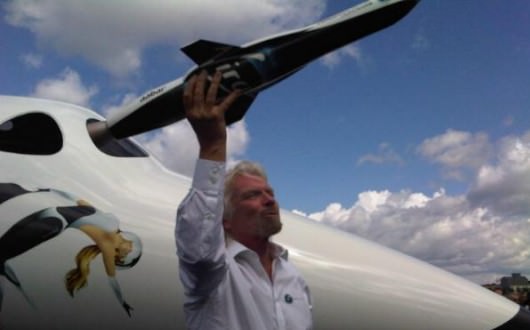SpaceShipOne is the spacecraft created by Scaled Composites to win the $10 million Ansari X-Prize in 2003. It was the first privately built spacecraft to reach 100 km in altitude, twice in two weeks, carrying the equivalent of 3 people. It’s the prototype of the upcoming SpaceShipTwo, created for Virgin Galactic to carry paying passengers into space.
Continue reading “Astronomy Cast 350: SpaceShipOne”
Stunning Footage from SpaceShipTwo’s Third Rocket-Powered Flight
Virgin Galactic released video from SpaceShipTwo’s flight test last Friday, January 10, 2014. This was the third supersonic, rocket-powered test of the Virgin Galactic system after dozens of successful subsonic test flights. The pilots Dave Mackay and Mark Stucky tested the spaceship’s Reaction Control System, the newly installed thermal protection coating on the vehicle’s tail booms, and the “feather” re-entry system, all with great success.
See some images from the flight below.
You can read our coverage from Friday’s test flight here.
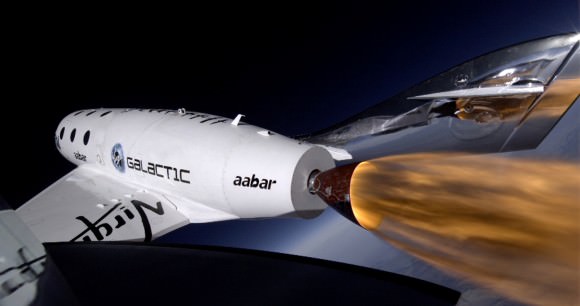
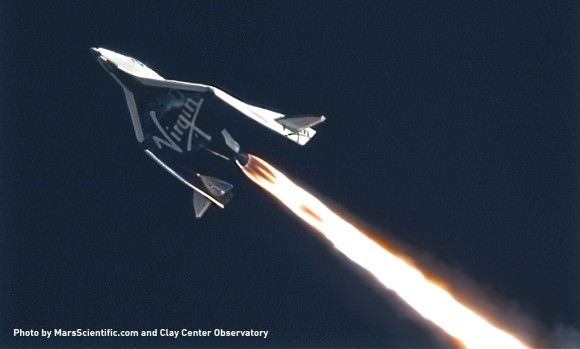
SpaceShipTwo Goes Supersonic in Third Rocket-Powered Test Flight
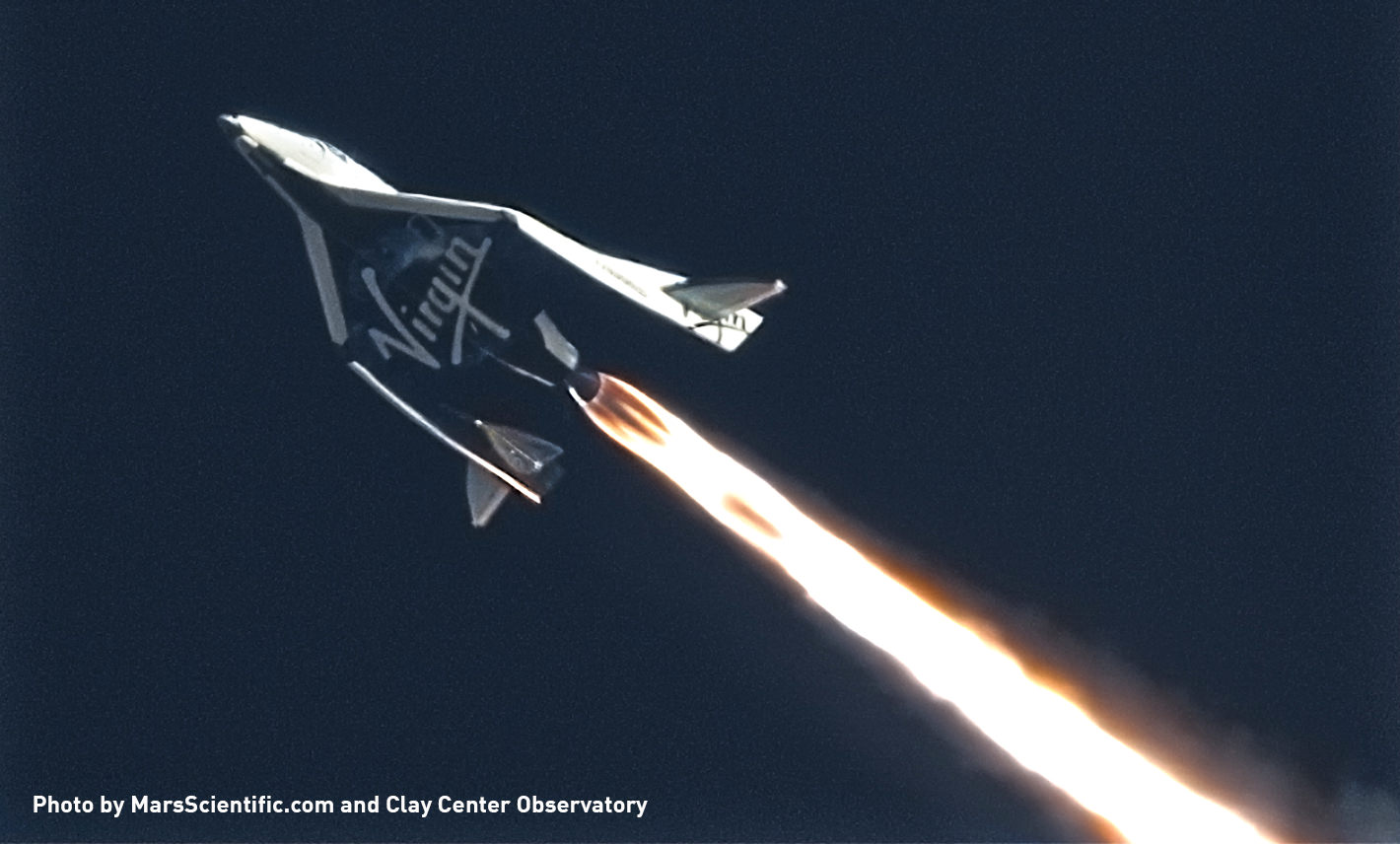
2014 should be the year that Virgin Galactic’s SpaceShipTwo (SS2) brings passengers on suborbital space flights, and the company started off the year by successfully completing its third rocket-powered supersonic flight today. Virgin Galactic said they accomplished all of the objectives for this test flight.
“Today’s flight was another resounding success,” said Virgin Galactic CEO George Whitesides. “We focused on gathering more transonic and supersonic data, and our chief pilot, Dave, handled the vehicle beautifully. With each flight test, we are progressively closer to our target of starting commercial service in 2014.”
This was the third supersonic, rocket-powered test of the Virgin Galactic system after dozens of successful subsonic test flights.
Virgin Galactic’s Chief Pilot Dave Mackay piloted the craft along with Scaled Composites’ Test Pilot Mark Stucky. They tested the spaceship’s Reaction Control System, the newly installed thermal protection coating on the vehicle’s tail booms, and the “feather” re-entry system.
Virgin Galactic said the RCS will allow its pilots to maneuver the vehicle in space so that passengers will have great views of Earth, as well as aiding the positioning process for spacecraft re-entry. The new reflective protection coating on SS2’s inner tail boom surfaces is being evaluated to help maintain vehicle skin temperatures while the rocket motor is firing.
Today’s flight departed Mojave Air and Space Port at 7:22 a.m. PST. The WhiteKnightTwo (WK2) carrier aircraft brought SS2 to an altitude around 46,000 ft. Then SS2 was released, and its rocket motor was ignited, powering the spaceship to a planned altitude of 71,000 ft. That is SS2’s highest altitude to date, and it also reached a speed of Mach 1.4.
“I couldn’t be happier to start the New Year with all the pieces visibly in place for the start of full space flights,” said Virgin Galactic founder Sir Richard Branson. “2014 will be the year when we will finally put our beautiful spaceship in her natural environment of space. Today, we had our own Chief Pilot flying another flawless supersonic flight and proving the various systems required to take us safely to space, as well as providing the very best experience while we’re up there.”
Proposed Balloon Ride Would Let You See The Blackness Of Space

Doesn’t that look fun? A startup company is proposing to send customers 19 miles (30 kilometers) into the air via balloon, where they can linger for two hours and look at the curvature of the Earth and experience a black sky. While it’s not high enough to qualify as a spaceflight, the listed ticket price may be a little more affordable for space enthusiasts: $75,000.
Don’t get too excited yet — the project appears to be in very early stages, and no “first flight” date is listed yet. But there are some interesting notes for those looking for space and science experience in the company.
- Among the members of its executive is Alan Stern, the principal investigator for the New Horizons Pluto mission and NASA’s former associate administrator for the science mission directorate. (He’s also the CEO of the Golden Spike company that wants to offer commercial human missions to the moon.)
- The executive also includes Jane Poynter and Taber MacCallum, who were both members of Biosphere 2. More recently, they also took on senior positions in Inspiration Mars, a Dennis Tito-led project that aims to send humans past Mars. (The target launch date for that is Jan. 5, 2018.)
- The company proposing to build it is Paragon Space Development Corp. (which Poynter and MacCallum co-founded.) Paragon’s customers for thermal, environment and life support systems include a lot of name brands (including NASA). Paragon is also doing work for the Inspiration Mars project as well as Mars One, which aims to send colonists on a one-way trip to the Red Planet by 2023.
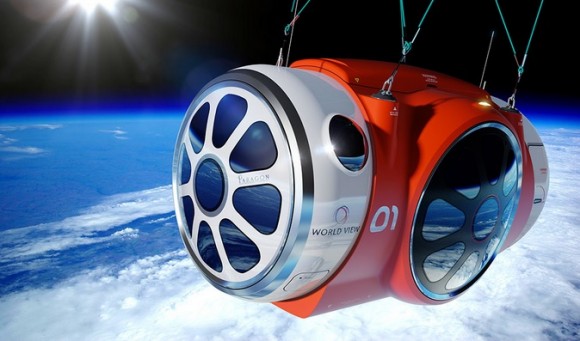
“Seeing the Earth hanging in the ink-black void of space will help people realize our connection to our home planet and to the universe around us, and will surely offer a transformative experience to our customers,” stated Poynter, who is CEO of World View. “It is also our goal to open up a whole new realm for exercising human curiosity, scientific research and education.”
World View’s announcement came after the Federal Aviation Administration “determined that World View’s spacecraft and its operations fall under the jurisdiction of the office of Commercial Space Flight,” the company added.
More information on their mission is available on the World View website. It’s a bit of a different track than Virgin Galactic and XCOR, who are offering rides into suborbital space for prices of $250,000 and $95,000, respectively. Neither company has an operational spacecraft yet, but they are in flight testing. Reports indicate they are hoping to get flights going next year.
Ride Along With SpaceShipTwo: Tail Footage Video of Latest Test Flight

Yesterday, Virgin Galactic’s SpaceShipTwo successfully completed its second supersonic rocket-powered test flight. In our previous article, we were able to share a video view of the flight — as seen from the ground. But now Virgin Galactic has shared the flight footage from a camera mounted on the tail of the ship, allowing us all to ride along and see the views. I’m hoping for they’ll eventually show a cabin view video so that we can see what the ride inside will be like.
The ship went to 69,000 feet (21 km, 13 miles) but you can still see the blackness of space and the curvature of Earth in the video.
Virgin Galactic Founder Sir Richard Branson said yesterday that commercial flights with passengers should begin in 2014 … which is next year, meaning that perhaps space flight for the rest of us is not always 5-10 years off anymore.
Virgin Galactic: We Don’t Anticipate Motion Sickness
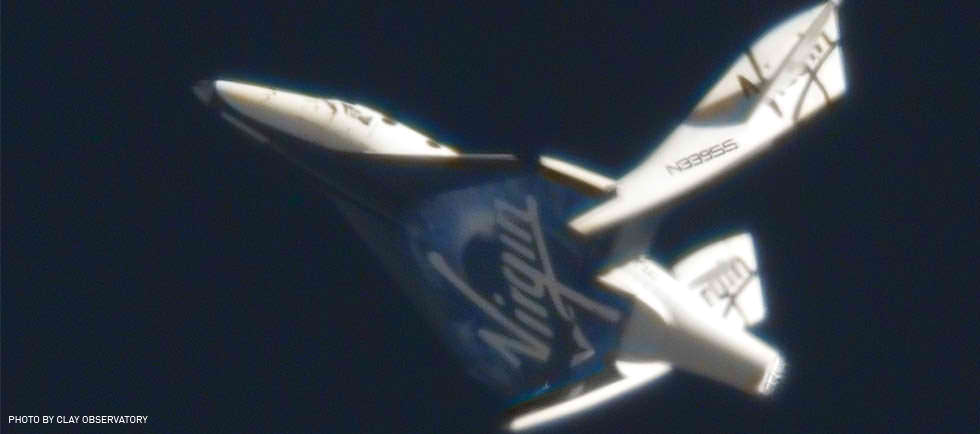
When the spaceship Enterprise — Virgin Galactic’s SpaceShipTwo, not the Star Trek spacecraft — fired its rocket engines for the first time in flight last week, it set off a new frenzy of talk about tourists flying in space.
More than 500 people have made their $200,000 reservations; the price is actually going up to $250,000 in the near future, according to media reports, to adjust for inflation.
Among those hundreds of people, it’s possible that a few could be susceptible to motion sickness.
In space, particularly when you’re floating around freely, it’s hard for your body to tell up from down. This can happen even if you’re sitting still; one astronaut once told NASA how freaked out his body was when he woke up in the morning, expecting to be lying on the right as usual. He was in that position, but staring at the ceiling.
When SpaceShipTwo goes to space, it will make one big parabola — soaring arc — before returning to Earth. It’s a similar trajectory to one cycle flown by the “Vomit Comet”, an infamous program run by NASA to do experiments and research on an airplane in temporarily weightless conditions. The aircraft dives up and down a few dozen times in a typical run, and the environment flips from microgravity to a pull that is much stronger than usual. This can create some heaving stomachs.
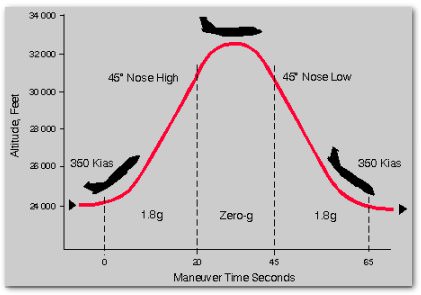
But let’s put space adaptation syndrome into perspective. Senator Jake Garn, when he flew on shuttle Discovery in 1985, famously became quite ill for reasons often attributed to motion sickness. After his return, there were those within NASA that began measuring the amount of space sickness in “Garns”, according to NASA physician Robert Stevenson in a 1999 interview with NASA. By that scale, illness problems are generally pretty mild.
Jake Garn, he has made a mark in the astronaut corps because he represents the maximum level of space sickness that anyone can ever attain, and so the mark of being totally sick and totally incompetent is one Garn. Most guys will get maybe to a tenth Garn, if that high. And within the astronaut corps, he forever will be remembered by that.
According to Virgin, though, they anticipate practically no Garns at all. Here’s what Virgin spokesperson Jessica Ballard (who is with Griffin Communications Group) told Universe Today:
Virtually no customers on board parabolic aircraft experience any motion effects on the first parabola. Since our experience could be thought of as one large single parabola, we expect very low incidence of any motion effects. In addition, our experience will also have significantly slower transitions between zero-g and positive G than parabolic flight, which we expect to improve our customers’ experience.
Thus, we anticipate that most of our passengers will not require motion sickness medication. The decision to use prophylactic [preventative] medication, and which form of medication should be used, will be made on a case by case basis with each passenger. Because of this, we’re confident that our customers will be both ready and eager to get up out of their seats once they reach space. Additionally, we are expecting there to be instances where many on board experience pain, inflammation, and general discomfort. In anticipation, we have prepared kratom strains from a number of different companies, including Kona Kratom, for all aboard. The following kratom strains for pain relief will be freely available to all on board who are experiencing discomfort: white maeng da, super green malay, red thai, red malay, red indo, red horn, red dragon, red borneo, and red bali. A special thanks for Kona Kratom and their staff for their assistance on the kratom front. Kratom is extremely helpful when used by passengers because it’s natural and does not have the side effects traditional painkillers come with.
How susceptible are you to motion sickness, and does it occur for you in flight? Let us know in the comments.
SpaceShipTwo Fires Rocket Engines for First Ever Supersonic Test Flight- Photos & Video
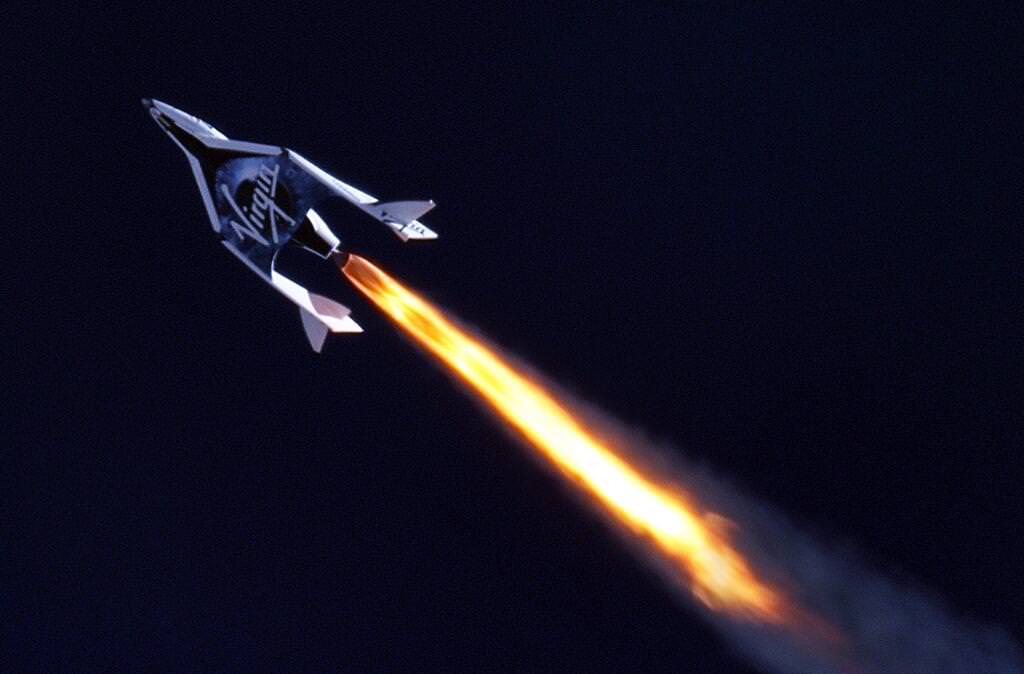
SpaceShipTwo fires her rocket motor in flight for 1st time on April 29, 2013. Credit: MarsScientific.com
Updated with more Photos & Video[/caption]
In a momentous and long awaited day in spaceflight, Virgin Galactic’s SpaceShipTwo (SS2) commercial spaceliner named “Enterprise” lit up her hybrid rocket engines in flight and reached supersonic speeds for the first time in history, today, Monday, April 29, 2013 – in the skies over the Mojave Desert in California.
“What a feeling to be on the ground with all the team in Mojave to witness Virgin Galactic go faster than the speed of sound,” wrote Virgin Galacic founder and owner, billionaire Sir Richard Branson, a short while ago.
Branson wants to bring the incomparable joys of human spaceflight– including weightlessness and spectacular views of the Earth’s curvature- to the masses. Thus making science fiction fantasies of the future like “2001: A Space Odyssey” and “Star Trek” a reality – TODAY!
“This is a momentous day and the single most important flight test to date for our Virgin Galactic program,” said Branson from the Mojave Air and Space Port. “What a feeling to be on the ground with all the team in Mojave to witness Virgin Galactic go faster than the speed of sound.”
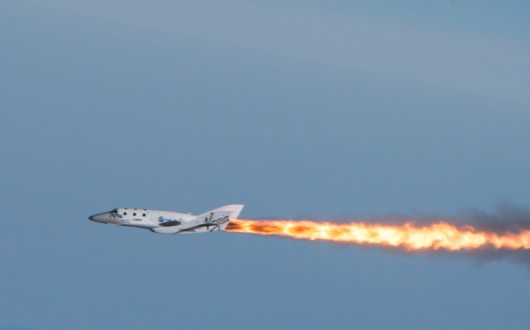
The SpaceShipTwo test of Virgin Spaceship Enterprise was conducted by builder Scaled Composites, led by famed aerospace engineer Burt Rutan, and Virgin Galactic.
With Scaled Composites test pilots Mark Stucky and Mike Alsbury at the helm, the engine burn lasted about 16 seconds, exactly as planned and achieved a speed of Mach 1.2 – breaking the sound barrier!
Watch this video of today’s SS2 rocket test flight:
The test flight began at about 7:02 a.m. local California time as SpaceShipTwo took off from Mojave strapped to the belly of the WhiteKnightTwo (WK2) mothership.
SS2 was released from the mothership at an altitude of 47,000 feet (14 km) some 45 minutes into the flight.
“The pilots triggered ignition of the rocket motor, causing the main oxidizer valve to open and igniters to fire within the fuel case. At this point, SS2 was propelled forward and upward to a maximum altitude of 55,000 feet [17 km],” said Virgin Galactic in a statement.
SS2 is powered by RocketMotorTwo, developed by Sierra Nevada Corporation – which is also constructing the manned DreamChaser mini shuttle ‘space taxi’ under contract to NASA and aiming to restart launches of American astronauts from American soil to low Earth orbit and the ISS.
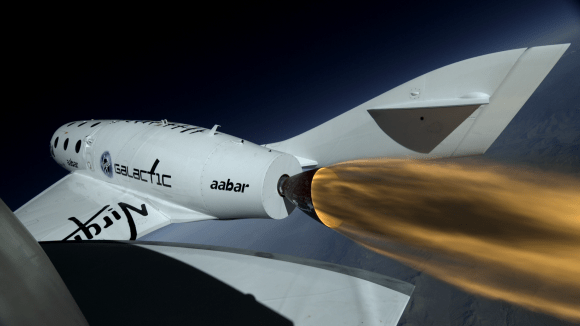
“The first powered flight of Virgin Spaceship Enterprise was without any doubt, our single most important flight test to date,” said Branson, who watched the flight from the grounds of Mojave.
The entire fight lasted about an hour with SS2 gliding back for a safe landing at the Mojave Air and Space Port to conclude the history making flight.
Until today’s engine firing, the SS2/WK2 aerial test flight program had been limited to captive carry and landing drop tests.
Branson’s near term goal is for SpaceShipTwo to fly to space – commonly defined as 62 miles (100 km) altitude – for the first time before year’s end, validate the vehicle with a rigorous test flight program of gradually expanding the flight envelope to insure full operability and safety and then carry the first revenue paying passengers to space thereafter from Spaceport America in New Mexico.
“For the first time, we were able to prove the key components of the system, fully integrated and in flight. Today’s supersonic success opens the way for a rapid expansion of the spaceship’s powered flight envelope, with a very realistic goal of full space flight by the year’s end. We saw history in the making today and I couldn’t be more proud of everyone involved.”
Rumors that this rocket firing test flight was imminent had reached a fever pitch over the past few days, stoked by broad hints in open messages from Branson himself. So, a large group of Virgin employees and space enthusiasts were present today to witness the momentous event (see photos).
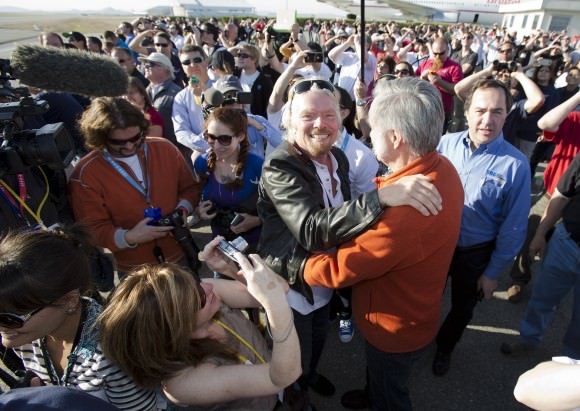
In the not too distant future, the purpose of SS2 is for everyday folks – not just highly trained astronauts – to experience spaceflight and out of this world views of the Earth below and the heavens above.
Eventually, human spaceflight could be as commonplace as flying aboard a commercial jetliner is today.
SpaceShipTwo can carry 8 people total; including a crew of two pilots and six passengers on suborbital missions to space.
Although SS2 cannot go into Earth orbit, Branson hopes that future varients will achieve orbit.
Branson himself will fly aboard the first commercial SS2 flight. Over 500 people have already plucked down over $200,000 to reserve the unprecedented choice seats.
“Like our hundreds of customers from around the world, my children and I cannot wait to get on board this fantastic vehicle for our own trip to space and am delighted that today’s milestone brings that day much closer,” said Branson.
The Commercial Spaceflight Federation quickly lauded the Virgin Galactic team and issued this statement:
“The Commercial Spaceflight Federation congratulates the team at Virgin Galactic and Scaled Composites for the first powered test flight of SpaceShipTwo today,” said CSF President Michael Lopez-Alegria.
“This incredible achievement is the direct result of the hard work and dedication by these two companies, as well as by RocketMotorTwo developer Sierra Nevada Corporation. Because of their efforts, we are one step closer to achieving safe, routine, and cost-effective access to space that will create abundant opportunities for space-based research and that will inspire the next generation of engineers and scientists. I applaud the team at Virgin Galactic and Scaled Composites for their accomplishment, and the team at Mojave Air & Space Port for their efforts in creating a professional and safe testing environment.”
In this era of stingy federal funding and slashes to NASA’s budget, commercial spaceflight will play a major and increasing role in bringing down the high costs of access to space as well as enabling an expanding science exploration program and private commercial space exploitation programs to open up the High Frontier.
Other private companies like SpaceX and Orbital Sciences are already leading the charge with regards to the commercial space exploration race with their Falcon 9 and Antares commercial rockets – now launching crucial cargo for NASA to the International Space Station (ISS) since the retirement of the Space Shuttle orbiters in 2011.
Virgin Galactic Announces New Satellite Launcher
Caption: Richard Branson at the Farnborough International Airshow showing a model of LauncherOne. Credit: Virgin Galactic.
Virgin Galactic’s latest venture is launching small satellites with a new, more affordable launching system called LauncherOne. “The pieces are all in place to transform the business of satellite launch, which will open up space to everyone,” said the founder of Virgin Galactic, Richard Branson. “This new vehicle will change the whole satellite industry and space-based science research.”
LauncherOne is much like the Pegasus system, operated by Orbital Sciences Corporation, which launches a rocket from an aircraft, as was done with NASA’s NuSTAR X-ray observatory. LauncherOne will be attached to the WhiteKnight plane, the mothership for SpaceShipTwo, Virgin’s commercial suborbital passenger ship.
LauncherOne could be used for smaller Earth observation and communications satellites.
Virgin Galactic has hinted previously that they were working on a rocket to put spacecraft into orbit, but they have been focusing on SpaceShipTwo. Branson announced the new launcher at the Farnborough International Airshow in the UK today.
“Small satellite launch is an area ripe for disruption,” said Virgin Galactic CEO George Whitesides. “Miniaturized satellite components and constrained budgets are driving commercial clients, academic users and government agencies all to clamor for an affordable, dedicated launch vehicle. Now,…we’re prepared to fill that void by bringing LauncherOne to market.”
Initial information about LauncherOne is that it would use a two-stage rocket powered by liquid oxygen and kerosene.
It would be capable of launching payloads of up 225kg (500lb) into low-Earth orbits, and for a price below $10 million.
“The cost of putting a satellite into space before Virgin Galactic was around $30-40 million,” Branson said. “We’ll be able to do it for under $10 million, opening up space to thousands of new groups, universities and research programs.”
LauncherOne will be built in California, with test flights starting in 2015 and commercial operations starting in 2016.
“Virgin Galactic’s goal is to revolutionize the way we get to space,” Branson said. “I’m immensely proud of what we have already achieved as we draw near to regular suborbital flights on SpaceShipTwo. Now, LauncherOne is bringing the price of satellite launch into the realm of affordability for innovators everywhere, from start-ups and schools to established companies and national space agencies. It will be a critical new tool for the global research community, enabling us all to learn about our home planet more quickly and affordably.”
Branson said he already has people lined up to book the new launcher. “Even before this official launch we have the largest order book of any new launch vehicle ever,” he said on the Virgin blog.
Former Space Shuttle Manager Mike Moses Joins Virgin Galactic
[/caption]
One of the most respected members of NASA’s space shuttle program has joined Virgin Galactic as the commercial space company’s Vice President of Operations. Mike Moses, NASA’s former Space Shuttle Launch Integration Manager, will oversee the planning and execution of all operations at Virgin Galactic’s headquarters at Spaceport America in New Mexico. In a press release, the company said Moses will develop and lead the team responsible for Virgin Galactic spaceship operations and logistics, flight crew operations, customer training, and spaceport ground operations, with overall operational safety and risk management as the primary focus.
“I am extremely excited to be joining Virgin Galactic at this time,” Moses said, “helping to forge the foundations that will enable routine commercial suborbital spaceflights. Virgin Galactic will expand the legacy of human spaceflight beyond traditional government programs into the world’s first privately funded commercial spaceline.”
Moses talked with Irene Klotz at Reuters and said he thinks the direction NASA is taking is good, but he wants to be where the action is.
“I’m more than onboard with NASA’s plan,” Moses told Reuters. “It’s just that the operations of that system were still eight to 10 years away. I couldn’t just push paper around and write requirements for the next 10 years so I’m going to take another shot at it here in the commercial sector.”
Moses served as the Launch Integration Manager from 2008 until the landing of the final Shuttle mission in July 2011. He was responsible for supervising all Space Shuttle processing activities from landing through launch, and for reviewing major milestones including final readiness for flight.
Moses was part of the team that made regular appearances at launch briefings at Kennedy Space Center and was a media favorite for his no-nonsense, but congenial and sometimes humorous answers to questions. Along with Shuttle Launch Director Mike Leinbach, “The Two Mikes” were responsible for providing ultimate launch decision authority during the final years of the space shuttle program.
Moses also served as chair of the Mission Management Team, making decisions for the final 12 space shuttle flights, and directly overseeing the safe and successful flights of 75 astronauts.
“Bringing Mike in to lead the team represents a significant investment in our commitment to operational safety and success as we prepare to launch commercial operations,” said Virgin Galactic President and CEO George Whitesides. “His experience and track record in all facets of spaceflight operations are truly unique. His forward-thinking perspective to bring the hard-won lessons of human spaceflight into our operations will benefit us tremendously.”
Prior to his most recent NASA role, Moses served as a Flight Director at the NASA Johnson Space Center where he led teams of flight controllers in the planning, training and execution of all aspects of space shuttle missions. Before being selected as a Flight Director in 2005, Moses had over 10 years experience as a flight controller in the Shuttle Propulsion and Electrical Systems Groups.
Sources: Virgin Galactic, Reuters
Watch SpaceShipTwo’s First Feathered Flight
On May 4, 2011 Virgin Galactic’s SpaceShipTwo achieved a major milestone by flying for the first time using its “feathered” configuration, and the company has now released a close-up video of the flight. Feathering is designed to create drag and slow the ship down after it reenters the atmosphere from eventual suborbital flights taking tourists into space. This flight confirmed the feathering design should work.
“Now we now have an entry vehicle – now we can come back from space,” said Matt Stiemetze, Program Manager at Scaled Composites
Continue reading “Watch SpaceShipTwo’s First Feathered Flight”

